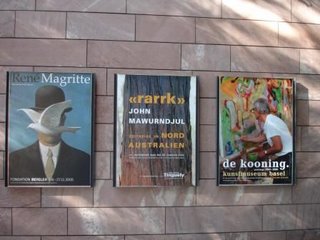
Two giants of European contemporary art flank an emerging giant of the art world in posters on a wall in Basel, Switzerland. John Mawurndjul is from Maningrida, a community of 2000-odd at the mouth of a river in Central Arnhem Land. Mawurndjul was on the cover of Time magazine earlier this year and is one of a half-dozen Aboriginal artists from various parts of Australia who have contributed work to the interior design of the Musee de Quai Branly in Paris. He painted a supporting column and part of the ceiling.
The 'rarrk' in the poster refers to the cross-hatching and other devices in bark and body paintings that bury the real meaning of the story that's been painted. An Aboriginal painting in these domains is not simply a work of art; it's also a statement of identity, inheritance and right - right of ownership of land or to a ceremonial story that confers responsibilities for land, resources or family. That true story is closed to people who are not entitled to know it, but they may be told an abridged and simplified version - the 'outside' story - while the real one - the 'inside' story' - remains safe and secure in plain sight.
I'm flying out there tomorrow on a work visit, looking at how the community is managing on the Community Development Employment Project. It's a program through which people voluntarily work for their legal entitlement to unemployment benefits. The program is under attack from the Federal Government, which wants Aboriginal people everywhere to have 'access to the free market' and embrace capitalism. Both of these are difficult concepts for people like Mawurndjul, whose apparently considerable income from painting supports an extended family.
More on this later, when I get back.
No comments:
Post a Comment